What kind of heating is there in a private house? Types of heating systems for a private house - varieties with examples
1.
2.
3.
Exist different kinds heating systems of a private house. But all of them can be divided into three types: air, electric and water. Each of them is divided into several types depending on the heater, energy source, and method of coolant supply.
All types of heating systems for a private home have their own characteristics, so before choosing one of them, you need to carefully familiarize yourself with their features. You can see what modern heating systems look like in the photo.
Air heating in a private house
This type includes gas and electric convectors, stoves of various types. There is no coolant in these devices, and the air in the room is heated directly from them.These types of heating systems warm the room through air convection. This happens as follows: cold currents, passing through the blinds and hot plates of the device, heat up and penetrate into the room. The devices may have a fan that forces air into the room and quickly warms up the room.
Similar functions have gas convectors, however, they require gas pipe and a chimney to remove combustion products. Devices created using new technologies make it possible not only to heat a house, but also to heat water for domestic needs (more details: " "). Among air heaters of this type electrical devices does not exist.
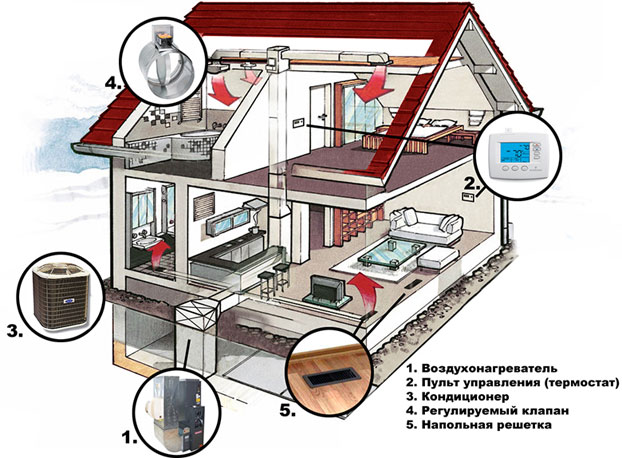
Stoves are still very popular. Moreover, modern devices have high efficiency. For example, the Buleryan stove has an efficiency of 95%, and, depending on the modification, is capable of heating a house with an area of 100-1000 square meters. Such devices operate on wood; one load of fuel is enough for 7-10 hours (read: "").
The furnace body is surrounded by pipes covered with a casing. The surface of the device does not heat up much, but the air coming out of the pipes reaches a temperature of 160 degrees. Such stoves are very convenient for heating private houses and country houses where people visit infrequently, as they allow you to quickly heat the air. At the same time, they do not depend on an energy source other than firewood.
Water heating systems
Although there are other types heating systems, which are in many ways more convenient, water ones are still one of the most common in the city. Moreover, they are used both in multi-storey buildings and in private sector houses.For wiring, pipes made of copper, steel, polypropylene, and plastic are used. Sometimes several materials are combined for the purpose increasing efficiency or improving ease of installation. There are different types of heating in a private house, based on pipe routing. Boilers and radiators, as well as “warm floor” systems are used as the main device.
The main part of the water heating system is a boiler (gas, solid fuel, liquid fuel), stove, electric heater (electrode or heating element). The modification of these devices varies. There are multi-fuel and universal models that can use different types of fuel, for example, gas and diesel or wood and gas.

Recently appeared new type electric heaters – electrode. In this type of heating system there is no heat exchanger, and the liquid is heated by the movement of electrons at a speed of 50 Hz, which is 50 cycles per second. Such devices can operate without forced circulation, and if necessary, they can be combined with boilers of another type, or installed in one system parallel to each other.
Water circuits can be single-pipe or double-pipe. IN two-pipe systems The coolant is supplied to the heating devices through one pipe and returned through another. In this case, the water temperature does not depend on the number of radiators and only decreases slightly when passing through the pipe, which practically does not affect the heating efficiency. In such systems, water supply can be forced or natural.
Efficiency single pipe system depends on the number of radiators, since the coolant is cooled when passing through the pipe, and when it enters other batteries it already has a lower temperature. If the water supply in a single-pipe circuit is arbitrary, then it is better to install no more than three radiators. When using a circulation pump, there should be no more than five batteries per pipe.
Water types of heating of a private house differ in appearance and the material used to make radiators. They are sectional, columnar and panel. As for the material, radiators can be made of steel, cast iron, aluminum, bimetal. Cast iron batteries not recommended for use in, since their lower part is wasted a large number of coolant, and as a result, the consumption of the energy source increases. Heating devices of this type can have bottom and side connections.
Depending on what material the batteries are made of, they have their own characteristics. If you have any doubts about choosing a particular radiator, it is better to choose bimetallic products - they are durable, heat up quickly and just as quickly release heat to the room.
Considering what types of heating there are, one cannot help but pay attention to “warm floor” systems. The water system is laid in a snake or spiral, using metal-plastic or polyethylene pipes. The efficiency of these two materials is almost the same, but metal-plastic is more convenient to install and costs less. After laying the pipes it is poured concrete screed, and mounted on top flooring, usually ceramic tile.
Types of electric heating
Air and water types of heating systems for buildings are cheaper than electric ones. Most heaters consume a considerable amount of electricity, so they are generally not used as the main source of heat.Among electrical devices, “warm floor” systems are quite popular. In this case, an infrared film is laid, on top of which the floor covering is mounted. Carpets should not be laid over infrared film, and it should not be placed in places where furniture is located. But “warm floor” systems are not able to effectively heat rooms; they are mainly used as an additional source of heat.

Currently, there are various types of heating schemes, each of which has its own advantages and disadvantages. When choosing suitable option you need to take into account a lot of factors: the area of the house, financial capabilities, the quality of the building’s insulation, the availability of energy sources.
Until recently, apartments were valued for a luxury unavailable in a private home - centralized heating systems. Now a lot has changed - our compatriots are trying to acquire own houses and install your own heating system at home. Such changes are associated with an increase in heating bills in apartments and with the development of technologies that make it possible to effectively heat houses at a reasonable price. Homeowners can independently choose the type of heating and ensure comfort in their homes. In order not to make a mistake, you need to navigate the types of systems heating devices, determine the availability of fuel.
Types of heating systems for a private home
The most widespread in our climatic conditions are water, air and electrical systems. As before, water heating is considered the most popular, but thanks to constantly introduced innovations, it is gradually losing ground, more attention is given combined systems and alternative types of home heating - solar, wind, geothermal energy, hydrogen. The following are used as fuel for the systems:
- coal;
- firewood;
- diesel fuel;
- electricity;
- fuel briquettes and pellets;
- energy received from the earth, sun, water, wind.
Modern heating systems are very diverse, alternative energy sources are increasingly used
Water heating: a tribute to tradition
This is a closed loop in which natural or forced circulation coolant - most often water, sometimes antifreeze. When the heating is turned off, the system may freeze, so in houses that are not constantly warmed up, it is better to give preference to antifreeze - a non-freezing liquid.
The coolant is heated using a boiler - gas, electric, liquid or solid fuel. Circulating through the system, the coolant transfers heat to the air, gradually cools down, returns to the boiler, and the cycle repeats. To ensure quality work circulation system are used additional elements – expansion tanks, pumps.
There are single- and double-circuit systems. The first are intended exclusively for heating, and the second are for heating the home and providing it hot water. Some homeowners install two single-circuit systems so that one boiler can be used for hot water supply in the warm season and both in winter or in the off-season. This allows you to heat water without starting the heating system.
Gas boilers
Today, gas is the cheapest fuel, so most homeowners install gas heating equipment. But we should take into account the constant increase in gas prices and the desire of more and more people to equip their homes with environmentally friendly heating systems. Another reason why you have to look for an alternative is the lack centralized systems gas supply in some localities.
Advantages gas heating in the house – economy, durability, efficiency, ease of operation and repair. Disadvantages include potential explosion hazard gas equipment, the need to connect to the gas main.
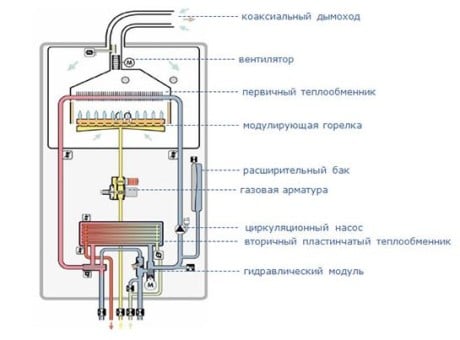
How a gas boiler works - design diagram
Liquid fuel boilers
To install such a boiler, you do not need a connection to the gas main. It is only necessary to have a source of electricity for the operation of the automation system and the ability to provide the system with fuel (diesel is most often used). Installing heating for a house designed for an oil-fuel boiler is no more difficult than installing gas equipment, and there is no need to approve documents for connecting to the main line. You can design and install the system yourself.
Liquid fuel boilers are very efficient, efficiency reaches 94%, but the cost of fuel is high, and the boiler room needs to be equipped separate room, exhaust system, which stops many homeowners.

Solid fuel boilers
Distinctive feature boilers capable of running on solid fuel lies in the variety of types of fuel itself, which allows you to choose the most profitable option for each homeowner. You can use coal, firewood, fuel briquettes and pellets. Solid fuel heating is often not equipped with automatic control systems, due to this solid fuel boilers can be installed even in houses not connected to the power supply.
Full autonomy and efficiency are undoubted advantages. The disadvantages include the need for constant monitoring and equipment of the fuel storage room. Stoves and fireplaces for heating a home also run on solid fuel and can be excellent sources of heat.

Solid fuel boiler - equipment diagram with a bunker for fuel pellets
Electric boilers
Electrical equipment safe, quite easy to install, does not require a chimney, takes up little space, and is considered environmentally friendly. As for the environmental friendliness of using electricity, this is a controversial issue, but ease of use, efficiency and compactness are important advantages. There is only one drawback: electricity is unprofitable as the main source of energy. It is better to install this system as a backup. To install electric boilers you need three-phase network 380 V. It is also advisable to purchase a spare generator.
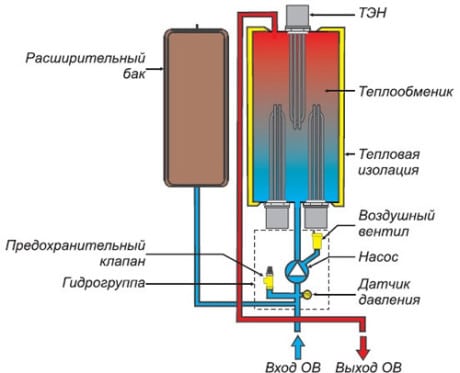
Diagram of an electric heating boiler
When choosing heating boilers, you should focus on the availability of fuel; it also makes sense to connect mixed boilers for home heating that can operate on different types fuel. Smart choice– a combined boiler for gas and wood, which can be quickly and easily converted to another type of fuel. It is also important to choose a model that is easy to operate and maintain.
Air heating: a worthy alternative to water heating
The system works like this: cold air enters the heat exchanger, heats up to 50-60°C, and then delivers it to the room. In the rooms, the air flows mix, the warm ones cool down, fall down and again enter the heat exchanger. Heating is carried out using a gas or diesel burner, hot water, heat pump. Air is transmitted through ducts.
Experts believe that installing air ducts that are too long will lead to more energy consumption for heating. The recommended length of air duct branches is 15 m, total length is 30 m. System integration air heating with ventilation expands the possibilities of creating a comfortable microclimate in the house. Optional equipment allows you to purify and humidify indoor air.
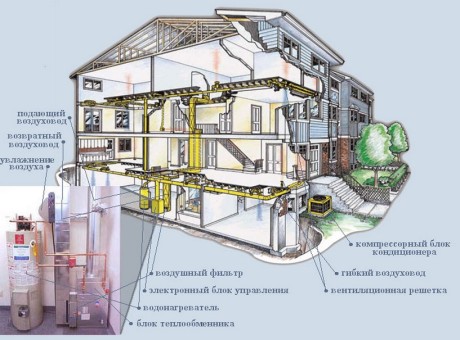
Air heating system country house
Electric heating: full control over the “weather in the house”
In European countries with mild climates electric heating gained popularity due to the ability to integrate it into systems " smart home" The equipment is compact, safe, adjustment and control are provided by full automation processes. The only significant drawback is high energy consumption. Most often, convectors are installed as heating devices. In regions with harsh winters and long heating season Such systems are unreasonably expensive. They are great as backup or additional, but not primary.
Technology development and new original engineering solutions Already now they can significantly reduce energy consumption by installing economical infrared floors or ceilings, but still the feasibility of using electricity for heating houses in our latitudes is questionable.

Alternative ways to heat your home
Humanity is gradually moving away from the large-scale use of hydrocarbons. This process is due to the depletion of irreplaceable resources, threats to environment. There are many developments that allow you to use alternative energy:
- solar collectors;
- heat pumps;
- installations for producing biogas, Brown's gas.
Heating a house with solar panels
The basis of the solar battery design is crystals that capture the sun's energy and a frame. One of the most significant shortcomings solar system– low efficiency, amounting to only 9-13%. Photocells are very fragile, subject to deformation and require careful handling. Despite the obvious advantages of solar systems: the use of inexhaustible resources, environmental friendliness and safety, they cannot yet become a full replacement for conventional energy sources and be used on a large scale for home heating.

Solar battery on the roof of the house
Use of wind energy
A wind generator consists of the generator itself, rotating wind catcher blades, batteries, and automation. The structures are installed on towers to capture and convert wind energy as efficiently as possible. There are models with horizontal and vertical axes. For energy supply and heating of the house, it is better to choose a vertical model: it is more compact. A wind turbine can only be effective in areas where strong winds constantly blow.
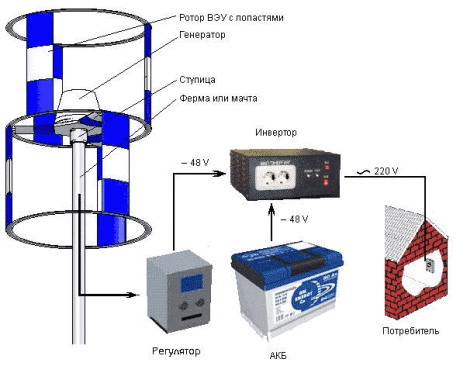
Heat circulation pumps
The operating principle of a heat pump is based on the conversion of energy potentials. Pump design:
- outdoor and inner contours with coolant;
- compressor;
- evaporator;
- capacitor.
The outer circuit is designed to absorb energy from the environment - air, water or earth. Antifreeze is usually used as a coolant. There are vertical and horizontal models. The type and model of the heat pump are selected individually for a specific building.

Biogas plants
Biogas plants or electrolyzers can be used as a gas source. Biogas is a mixture of carbon dioxide, methane, and hydrogen sulfide. The installation for its production is assembled from a tank for organic waste, a mixing auger, a hatch for adding waste and a pipe for gas removal. The installations can hardly be called safe, so the gas exhaust system should be designed as carefully as possible.
Using an electrolyzer involves heating a house with hydrogen. So far, there are only experimental models that are difficult to apply in our climatic conditions for full heating of buildings.
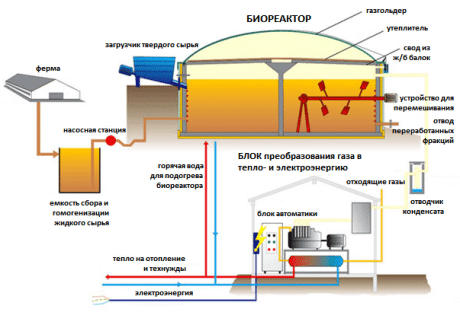
Structural elements biogas plant
Everyone can determine for themselves which heating is best for their home after familiarizing themselves with the types and features of heating systems. The purpose of this review is to indicate only the main directions for searching. If you are interested and decide to learn more about any of the systems, then the goal has been achieved, and after a more thorough study of the issue, you will be able to make a rational choice. Warmth and comfort!
Video: the cheaper way to heat a country house
